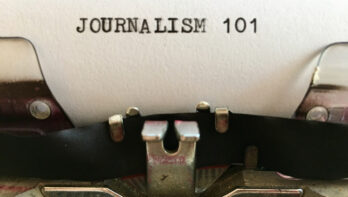There are three kinds of people in the world – those who are good with numbers and those who aren’t. That’s why it’s important to proofread numbers.
One example of this can be found in an article my hometown paper, the Minneapolis Star Tribune, ran a few years ago. The headline said that a team won a series 3-2, in game seven of the series. But 3 plus 2 equals five, not seven.
We need to proofread numbers. This can be hard, because many people wind up in journalism partly because they’re not number people – they’re word people. But we’re not usually talking about tricky math – three plus two isn’t that hard. You don’t even have to take off your shoes to do that calculation. We’re really just talking about checking the numbers to make sure they make sense. Sometimes word people just shut their eyes when they see numbers – they just turn their brains off. We suffer from MEGO syndrome – “my eyes glaze over.” Don’t do this – realize that your natural disinclination toward numbers makes them something you need to check.
For instance, here’s a sentence from a story about women’s professional basketball:
The ABL (American Basketball League) plays with the 30-inch diameter ball used in the men’s game, not the 28-1/2 inch ball used in girls’ high school and women’s college versions of the sport.
What’s the problem? The ball is described as having a 30-inch diameter. What’s diameter? It’s how far across something is. Does a basketball have a 30-inch diameter? Of course not. What happened here? The writer confused diameter (distance across) with circumference (distance around).
Here’s another example. PC Magazine, a respected computer publication, published this in 1990:
No one has estimated the number of words the average computer processes during its lifetime, but the amount could easily be in the billions.
Well, with an audience of computer nerds, you know somebody is going to check that, right? One reader found it would take 38 years of continuous data entry to reach a billion words.
Sometimes our eyes just glaze over with big numbers. That’s why a story about H. Ross Perot’s plans to cut government waste got it wrong, when it said he planned to cut $180 million in fraud and waste. That $180 million sounds like a lot, but it’s a drop in the bucket when it comes to the $1.5 trillion federal budget. Perot actually said $180 billion, with a B.
Something similar happened in a feature story about a TV show called “Dinosaurs.” The story said:
Dinosaurs thrived 65 billion to 175 billion years ago. Episodes of “Dinosaurs” are dated 60 million years ago, when in truth the dinosaurs were already extinct.
Well, here’s a basic rule to know: If you’re going to take somebody to task for having their numbers wrong, make sure you have yours right. Even your die-hard evolutionists figure the earth is maybe 2-3 billion years old. Plus, the two sentences don’t fit together – the first says “billion” and the second says “million,” which should have tipped off the copy editor.
Make sure the numbers make sense. In a story for the New York Times Magazine about Ivana Trump’s spending habits, the writer reported that Trump told her: “I go to [Bloomingdale’s] for two hours and I buy 2,000 of the black [bras], 2,000 of the beige, 2,000 of the white. Then I ship them around between the homes and the boat and that’s [the] end of it for maybe half a year, when I have to do it all over again.” Actually, Trump said she buys two dozen of each color every six months, but the writer apparently had a hard time understanding her Czech accent. If the writer had done the math she would have found that Trump would have to wear 33 bras each day, throwing each away after a single use, for the numbers to make sense.
Sometimes we put numbers into a table to make them easier to understand. This is a good idea, but also a chance to introduce an error. For instance, a newspaper ran a business story about hearing aids sold in the U.S. The table said the numbers were given in millions, and the number for ages 1-17 was 1,021. Problem? That would mean the real number was just over a billion – more than the total population of the U.S. Numbers were actually in thousands.
A story about a Hall of Fame running back said he rushed for 14,444 yards in four seasons at the University of Texas. With a big number, it helps to break it down to see if it could be reasonable. That would be 3600 per season. If they play 10 games per season (typical), it’s 360 yards per game. 100 yards is a good game for a running back.
My point? Proofread the numbers.
A simple calculator can help avoid problems – and some errors don’t even need a calculator. For instance, one story that made it into print said that 4,000 employees were going to be laid off, in addition to 1,200 laid off earlier, for a total of 1,500 layoffs. That’s one the writer and editors should have been able to do in their heads. Another story promised to provide the “Top 10 things that make people blush,” but the list had 14 items.
One thing that makes numbers difficult to proofread is that they have no redundancy. With letters, you can often tell from context what the word is supposed to be. You know that if somebody says a house is “yelow,” with one “l,” that there is a letter missing. But if somebody says a fundraiser raised $1,064 and it actually raised $10,640, there’s no redundancy to tell you that a number is missing.
Here are a few other tips to avoid problems with numbers:
Double-check ages to make sure they fit with other facts. I once saw a book that listed a person as having died seven years before their birth. Actually, they lived to be 93.
Watch out for reversed numbers. It’s easy to get two digits turned around.
Watch out for people misusing percentages. One published story said “A survey shows that 49 percent of the Italian male and 21 percent of Italian female respondents confessed to extramarital affairs.” But the headline that ran with the story said, “Seven out of 10 Italians have committed adultery.” What happened? They added percentages rather than averaging them.
A story published during a championship run by the Chicago Bulls said that fans who paid scalpers $1,000 per ticket to game six of the series would only get face value of $50 back if the Bulls won it in five and there was no sixth game. The writer said fans would take a 2000 percent loss. It’s hard to know how they figured that. It’s true that $1,000 is 20 times face value for a $50 ticket. But if you spent $1,000 for the ticket, the most you can lose is $1,000 – or 100 percent of you investment. It’s not like if the Bulls don’t play a sixth game the NBA is going to come to your home and take away $19,000 on top of what you already paid for the ticket.
Make sure that numbers in body copy match numbers in headlines, cutlines, graphs and charts. For instance, a profile of a college basketball player said he needed 432 points to become the all-time leading scorer, wile the caption said he needed 455 points. Another article said seven baseball players were ejected from a game, but the headline said eight. Be consistent.
Double-check dates – sometimes there’s no internal clue that a date is wrong. Verify it.
Make sure it’s a real date. A story in the student newspaper I advise once said a concert happened Sept. 31. Of course, the same lead sentence also had 10,000 people attending a concert in an auditorium which seats fewer than 1,500. Proofread numbers!
— by Doug Trouten
Doug Trouten, former executive director of EPA and taught journalism at Northwestern College in St. Paul, MN.





